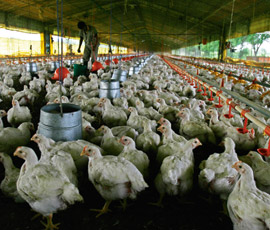Better outlook for poultry sector in 2013

Poultry businesses around the world should benefit from improving market conditions for the rest of 2013, though success will depend on how well they cope with volatile grain and oilseed prices.
Writing in the latest Rabobank Poultry Quarterly report, analyst Nan-Dirk Mulder points to the reduction in corn prices in recent months. “This has been a welcome break for an industry that saw margins shrink in many parts of the world throughout 2012,” he says.
In addition, the poultry industry should be able to benefit from its competitive price position against beef and pork in times of weak global economic performance, says the report.
Market balance
Supply discipline is already paying off in some key producing countries, it adds, where operators have actively sought to rebalance supply with local demand.
Brazil is a case in point, where poultry production was down by 12.6m tonnes, or 3%, in 2012, with domestic fresh poultry prices benefiting in the second half of the year, ending up some 7% higher year-on-year.
This has continued into 2013 and whole poultry prices were 42% higher at the end of January compared with January 2012 – the highest they have been since 2004.
Meanwhile, soya meal values have fallen sharply in recent months, says Rabobank, in anticipation of a record soya bean crop. They dropped 25% in January alone, benefiting margins for Brazil’s poultry integrators.
But the best performing local industries are in Russia and Ukraine, says Rabobank, with a good local supply and demand situation leading to higher margins.
“The recent sharp drop in pork prices has impacted broiler prices in the first quarter of 2013, although the current Russian price level is still historically high and adequate for positive margins in the industry,” says the report.
Production is also still growing in Russia, and has received a recent boost with the launch of a new $75m agricultural development plan, which will include a range of subsidies and tax breaks for the poultry and livestock sectors through to 2020.
Fragile recovery
In Europe, the Rabobank report points to slow improvements in processor margins, with some rebalancing of supply and better prices in the first part of 2013, thanks in part to better demand for leg meat in eastern Europe.
With overall poultrymeat consumption up 2% in 2012, the sector has enjoyed a “price umbrella” compared with the beef and pork sectors.
But the recovery is “fragile” and there is some concern that Germany is becoming an increasingly closed market, with welfare-conscious consumers shunning imports. This is forcing EU exporters to look for alternative outlets, with the UK and France seen as the most likely destinations.
Overall, the report says the outlook for EU poultrymeat is “positive” in 2013, aided by the slowdown in pork production following new EU welfare legislation, and higher beef prices.
“If the industry remains restrictive in supply growth, it should be able to return to higher margin levels, although the feed price outlook remains uncertain.”
Can China’s poultry move out of pork’s shadow?
Poultry producers in China have long lived in the shadow of the pork industry, which remains the meat of choice throughout the nation.
But a new report from Rabobank suggests that China’s poultry industry is set to outpace pork, thanks to the efficiencies it offers to both producers and consumers.
“Low current per capita consumption rates and a growing acceptance for eating poultrymeat amongst the younger generation, creates a strong growth potential that should enable the industry to take a meaningful share of meat consumption away from pork,” says analyst Chenjun Pan.
Much of this growth will come from the burgeoning fast food sector. KFC and McDonald’s have increased their outlet numbers to 4,000 and 1,500 respectively, with KFC claiming 39% of the fast food market.
Even if this sector fails to maintain its double-digit growth rate, there is still considerable opportunity in China’s nascent frozen or processed food market.
Poultry production in China is still much less industrialised than in other leading producers such as the USA, Thailand or Brazil, adds the report. Vertical integration is quickly gaining popularity, but contract farming is likely to remain the dominant business model as a result of prohibitive capital requirements, a lack of experience and rising land costs.
China also lags other poultry producing countries in terms of farm management, productivity, food safety and disease prevention.
Disease outbreaks have brought serious consequences to producers. In 2012 alone, avian influenza and other diseases have affected the industry several times.
Similarly, the feed model has come under fire, with consumers raising concerns over the use of growth promoters and medicines in poultry production.
